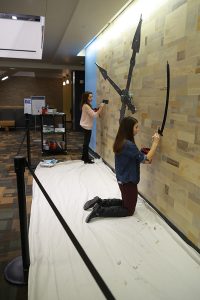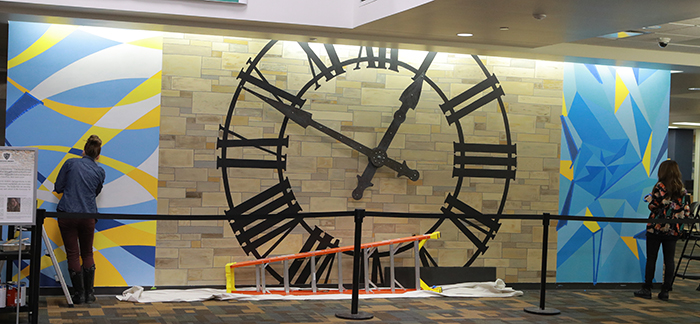Painting a visual narrative
Student artists take experiential learning process to the public
By Laurie B. Davis
What’s different about working independently on a painting for a class and collaborating with a partner on a public mural?
If you ask BFA students Tara Yarzand and Rose Mansel-Pleydell, who recently completed the front side of the clock tower mural in the William S. Carlson Library, they likely will say the two experiences are very different. And that is precisely the point, as the two young artists participate in the Carlson Library’s student experiential learning program.
Dave Remaklus, director of library operations at Carlson Library, recruited the two student painters through The University of Toledo Department of Art after acquiring the old clock hands from the University Hall clock tower.

“They ask, ‘are you hired, are you volunteering?’ says Mansel-Pleydell.
“Is the clock going to work? Will it tell time?” says Yarzand.
“Some people just come up and say, ‘this looks awesome,’ and then they go on their way,” says Mansel-Pleydell. “It’s almost like performance art. There could be a hundred people there at any moment watching us.”
Communication and compromise
The two young artists also have had to navigate making their ideas work in one unified piece. “We’re good teammates,” says Yarzand. “When you’re working with someone it’s good to learn how to compromise. We might have different ideas about something, and we would just talk to each other and reach a decision very fast. That’s a skill you need to learn and use in the real world,” she adds.
Mansel-Pleydell says it also has required good communication skills with Remaklus and the staff members who order their supplies. “Now that we’re doing this and getting paid, we have to be accountable for our supplies and our time; that’s definitely been a learning curve. Keeping track of the time and budgeting the speed at which we work,” she says. “Making benchmarks for our supervisors has been an important part of it, too, and will be valuable experience when we get out there and start working as professional artists,” says Mansel-Pleydell.
Gaining professional experience offers students an opportunity to lead a project and carry it out within a safe and semi-structured environment. “When you work independently and you need something for a project, you drive over to Art Supply Depo and you buy it,” says Mansel-Pleydell. “Now we had to plan ahead. We had to make a list. We had to do some research and figure out what kind of paint would work because neither of us have done a mural of this size before in this particular environment.

“Dave was very accommodating,” says Yarzand. “He gave us the time to decide. It’s been a safe space in which to learn, and now that we have the experience we can go out and do something similar to this in the future.”
The mural’s story, down to the mortar
The mural is 25 by 10-feet, with the clock hands mounted on a shaft right in the middle. “It all fell into place because we knew we wanted it to be roughly scale,” says Mansel-Pleydell.
The left-hand side that Mansel-Pleydell designed is where the mural story begins. “I really enjoyed learning about how to design arbitrary transparencies in one of my art foundations courses, so I used the two university colors, the blue and gold, and I’ve got these ribbons intersecting and crisscrossing over each other, and it just makes this aesthetically nice design,” says Mansel-Pleydell. “They also represent paths that are coming from different directions and converging on the University of Toledo. The clock pays homage to University Hall.”
Yarzand describes the design to the right of the bricks: “The design on the right-hand side is a shattered sky; it looks like shattered glass, and Toledo is the Glass City, so that is that. We are the Rockets, and it looks as though the Rockets hit the sky, so, the sky’s not the limit for the Rockets.”
The blue theme to the left and right of the brickwork loosely represents the sky that surrounds the tower. “It’s speaking about a trajectory of the University toward the future. The direction that we’re moving,” says Mansel-Pleydell. The mortar between the bricks features the more than 500 majors and career paths students can study and follow at UT. “Together they say, that’s the glue that holds the University together,” she adds.
“It’s all about the students and all about what we’re learning and where we’re going, and we think that’s a nice narrative and what it means to us. If somebody took the time to look at it and think about it, it could mean a lot of different things,” says Mansel-Pleydell.
Personal work
Every semester, the two artists create a body of work for a critique. The grade is pass or fail.

Yarzand’s work tends to be more abstract and incorporates masks. “Or it can be people with no faces, which can also be a mask,” she says. “I was always interested in masks because they can represent many things. They can hide identity or personality.” She says there also are masks that people put on each other, often representing a false perception. “This is the deeper meaning of what I want to do. The assumptions that people have about you or your identity; the unwanted masks,” says Yarzand.
Both young women transferred to UT from other schools. Yarzand also has a master’s degree in finance, and Mansel-Pleydell earned an associate’s degree in entrepreneurship.
The commonality between the two, they say, is that they studied subjects they were not passionate about until coming to UT to study art. “Now we are grateful to be doing what we love,” says Yarzand.
Library patrons can look forward to seeing Yarzand and Mansel-Pleydell during the spring semester, when they are scheduled to design the back side of the mural.







